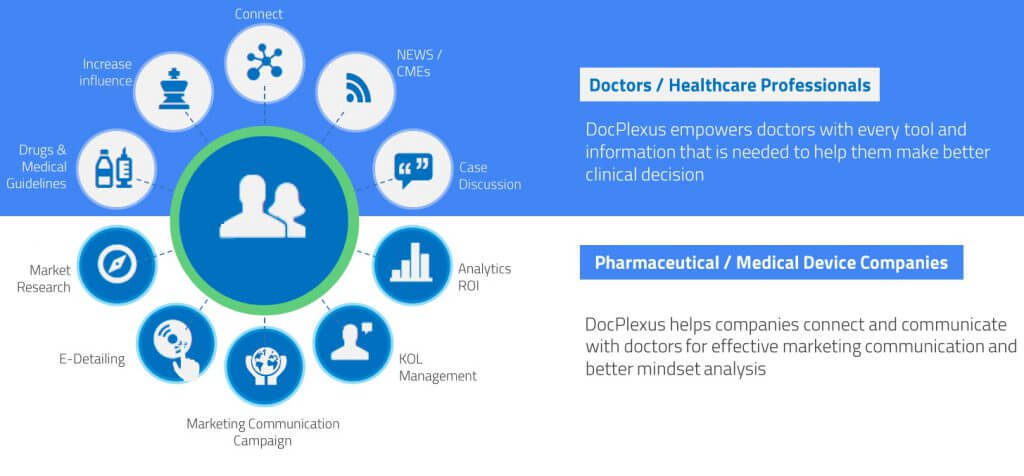
Customers in all sectors are opting for various means to connect with the manufacturers and service providers. Customers are using multiple channels to access various products and services and compare them with other products. The interaction of customers across the multiple channels with the company can be used for the marketing purpose to ensure message and information delivery. It also aids in understanding customer touch points.
Multi-channel marketing has evolved as the Healthcare industry’s fresh solution to the challenges of attaining improved commercial productivity with increasingly constrained promotional budgets. By merging traditional and digital engagement techniques, more cost-effective connections with key Healthcare stakeholders can be achieved.
Marketing in Healthcare is essential to raise visibility and to create overall brand awareness. The Healthcare sector is deemed as a service sector. Healthcare service providers and Healthcare product firms do not sell their products directly to the end users i.e. patients. Instead, their products are delivered by a variety of intermediaries who perform a variety of functions to deliver them to the end users. These participants work forming a channel for marketing either as a distribution channel / service delivery network or a marketing channel.
So how are the marketing channels formed in the Healthcare industry?
All Marketing channels are formed by the interdependent set of organizations which are involved in making a product or service available for the end user. In the Healthcare sector, medical practitioners, pharmacists and even patients are the participants of marketing channels for pharmaceutical products. On the other side, Healthcare product organizations, pharmacists and patients act as the marketing channel for the services of the doctor.
A general misconception amongst the Medical Professionals in India is that “marketing is the same as selling”. It is surely not! The leading marketing gurus never emphasized on targeting a sale of a product or service. In contrast, they always teach that marketing is building your identity by providing the best service to your end-users and building a long-term relationship. It is important to note that each member of the team who delivers a product or service to the end user is a valuable member.
Thus, the marketing channel system encourages systematic structures and management decisions enabling all the stakeholders to maximize the efficiency and increase margins by providing quality service. The choice of marketing channels is very critical as it can affect all management decisions of the Healthcare company, practitioner or service provider. Thus it is essential to devote the efforts towards choosing the right, profitable marketing channel where quality remains intact and not affected by compulsions of the channel.
Marketing Channels in Healthcare
The traditional channels of marketing in the Healthcare sector have a “push model”. The push model makes its sales force and other resources to motivate their intermediaries such as distributors, doctors to carry products, promote and sell the product or service. However, this model is very costly as it involves a lot of resources to promote and sell the products. Because there is a pressure of sales cascading from Manufacturer or service provider down in the channel, the entities which are the point-of-contact feel pressurized. This situation is often so pressurizing that the Doctors, Pharmacists (which are Point-of -Contact) feel that they have been pushed beyond their ethical limits.
The new evolving model considers the positives and negatives of the push-model. The new pull model is based on the best practices which are used in the other sectors. Though the medical sector is more complicated and very closely related to ethics than other sectors, many constituents of the Pull-model marketing can be effectively used.
The most important factor of the pull-model is that it enables engaging with end-users directly. The end-users i.e. patients (and in some cases doctors) are encouraged to ask for services and products from the intermediaries. This reduces the total costs for the manufacturer. The pull-model also increases the visibility and increases brand awareness among the end-users.
In India, the push-model is predominantly used. Pharmaceutical sector in India is engaged in marketing through its distribution channels. Distribution partners of pharmaceutical companies engage in selling the products in bulk and to generate the volumes for the manufacturers. The organized pharmaceutical sector comprising around 300 manufacturers accounts for 70% of products in the market. According to a leading advisory consultant, all these companies rely on the movement of the volume through their distribution channels. It is also found that the brand awareness for these companies is quite less than expected when compared with the volumes of brands outside India.
Not only pharmaceutical companies but also doctors and adjunctive providers lack visibility in the huge market such as India. So, what are the new strategies these companies or Healthcare providers should follow? The multi-channel marketing strategy may hold the answer.
Why is Multi-Channel Marketing Important: “The Segment for One” Approach
In the current Indian scenario, the challenge for the Healthcare sector is as much about quality as quantity; engaging in more bespoke collaboration with stakeholders that can drive mutually beneficial relationships. With that aspect in sight, multi-channel marketing is what the Healthcare sector needs to adapt to redefine its relationship with other Healthcare stakeholders, including doctors, nurses, and patients.
Healthcare companies face an additional challenge in terms of rebuilding closer relationships and trust with doctors, payers and patients. Without additional support to build such relationships, such key customers will inexorably continue to turn away from the companies. They will instead start relying on the multitude of non-pharma channels that are available for medical and drug information which may not provide right and suitable information. For effective relationship building, multi-channel campaigns must not only be commercially competent but also engage with such Healthcare participants on their own terms. Thus, planning and implementing customer-centric multi-channel marketing, where “the right information” is delivered to the “right customer” tailored for their needs, stronger relationships can be built and maintained.
Delivered in this personalized manner, multi-channel marketing strategies work well on both sides – the customer receives the information tailored for them, and pharma companies can invest in other critical activities by not wasting resources, which results in much stronger and mutually beneficial relationships.
How to Start Multi-Channel Marketing?
In order to gain a head-start in the market with Multi-Channel Marketing, organizations should embrace some the key strategies such as:
- Design long-term Multi-Channel Strategy: The delivery of the message should not be the same across all the channels of communication. It should be thoughtfully implemented to ensure “the right” messages reach the right audience at the right time with the right content
- Turn into a Data-savvy entity: It is important to collect, measure and analyze the data of all customer interactions across all the channels. Healthcare companies must adapt new strategies to engage directly with their most important intermediary i.e. doctors to ensure right data is received
- Engage with Information Technology: Healthcare companies need to adapt to the strategies of campaigning, marketing and behavioral analysis by effectively adapting IT solutions. Independent targeted-applications and technology companies should be engaged with prompt delivery of marketing materials and messages
- Engage in Smart Campaigning: In order to reduce the stress on the financials, the marketing campaigns should not be blanketed across all the customers. Campaign management tools can be effectively used to create segmentation much faster and can be tailored to specific segments effectively and efficiently
- Engage in Community Dialogues: Healthcare companies need to move away from the “Push” Model and engage in meaningful dialogues with the consumers to understand the perception and hurdles in the conversion to an actual sale. The engagement also allows companies to gauge the sentiments across different segments
How Can Multi-Channel Marketing Be Optimized?
The recent thrust due to constant evolution in technology and capabilities have made the delivery of highly tailored engagement to individual customers possible. This approach is often regarded as the “Segment for One” approach. The individual customer or patient in this way is targeted based on the evidence from the data gathered by digital measures.
How to Use Multi-Channel Marketing?
The technological push plays a very critical role in multi-channel marketing. With the help of the initiatives that Docplexus has taken, it is possible to engage with the right audience and deliver the information virtually. Through analyzing the data gathered, it is possible to optimize and adapt to the new ways of campaigning. This reduces the pressures of efficiency from the current marketing models and frees the resources committed for the use in more customer-centric areas.
There are various ways to implement a multi-channel marketing approach as we have seen earlier. The main goals of multi-channel marketing are:
- Tailoring campaigns for your target audience
- Focusing on various skills to engage the market
- Understanding and learning from previous campaigns
- Delivering content that is essential to your customers
These 4 essential goals of multi-channel marketing must be achieved by using various methods and modes of communication. One has to always remember that “engagement” with your customer drives marketing and adds to the brand value. Social media platforms and technological analytics tools can be effectively used for this purpose.
How Docplexus Enables Multi-Channel Marketing?
Docplexus believes in the engagement with one of the most important stakeholders i.e. Doctors in the Healthcare sector of India.
Docplexus ensures delivery of the accurate information to the right potential customers. We have more than 3,80,000+ registered doctors across 99 therapeutic areas. We have learned ways to engage with the “Right Audience” and drive them to get connected.
We engage with our members by:
- Providing them a platform for an engagement with each other to discuss a variety of medical topics ranging from patient cases to practice management
- Ensuring content of most relevance is generated by efficient experts and delivered to specific doctors
- Updating doctors with current trends and research so that they become self-motivated to search for the tools and resources which suit their purpose.
- Bringing them on our platform which acts as a “One stop Solution” for information, campaigns and products.

Docplexus offers exclusive access to unique and genuine customer insights on the perceptions, attitudes and behaviours of the medical community. Healthcare and Pharmaceutical companies profit from innovative communication opportunities that can drive best-in-class relationship-oriented customer and KOL interactions, communication and insights. With a mission to help companies to transform their version of the New Commercial Model into actionable programs through integrated experiences that are customized that create results.
